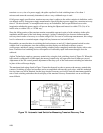
115
Figure 80. Four-Terminal Current Monitoring Resistor
Keep Temperature of R
M
Constant
Resistor R
M
should be protected against stray air currents (open doors or windows, air conditioning vents), since
these will change the resistance value, degrading the stability and temperature coefficient measurements.
Check Voltage Control Setting.
When measuring constant current performance specifications, the power supply's voltage control must be set
above the maximum output voltage that the supply will deliver, since voltage limiting action will cause a drop
in output current, increased ripple current, and other performance changes not properly ascribed to the constant
current operation of the supply.
Do not Connect DC Voltmeter Directly Across Power Supply Output Terminals.
Note that in Figure 79 the DC voltmeter used to monitor the output of the power supply is connected outside the
current monitoring resistor. Thus, the true output voltage of the supply is obtained by adding this voltmeter
reading to the voltage across the current monitoring resistor. If the voltmeter were placed on the left side of the
current monitoring resistor a change in output voltage of the constant current supply would result in a change in
current through the voltmeter input resistance. As can be seen from Figure 81, this change in current through
the incorrectly connected voltmeter will be accompanied by an equal magnitude change in current through the
load and the current monitoring resistor, thus degrading the measured constant current performance.
Of course, if a sufficiently high resistance dc voltmeter is used, this precaution need not be observed, provided
the voltmeter input current is small compared to the current change being measured.
Other precautions associated with the proper measurement of constant current power supply specifications are
given in the following paragraphs as required.


















